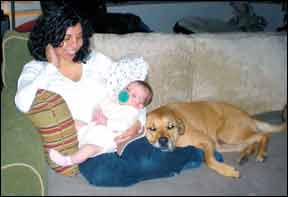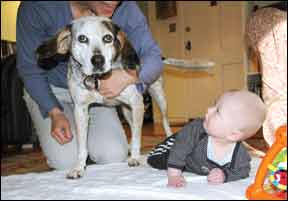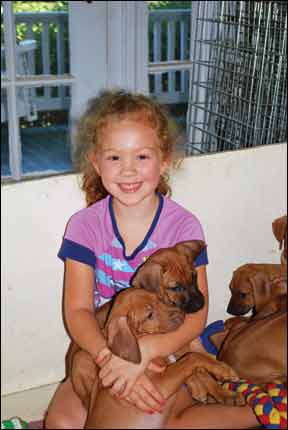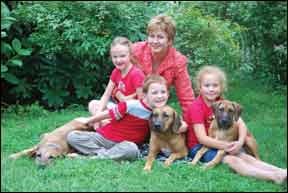[Updated February 27, 2018]
I’ve had my share of litters – and not just canine ones. You see, I’m the mother of triplets. When Stephen, Allie, and Krista came into my life – in that order, a couple of minutes apart – I had two middle-aged Rhodesian Ridgebacks. Blitz and Diva had certainly met children before, and didn’t mind them, but the arrival of the babies rocked their world.

Pre-kids, when my husband Fred and I went to work, the dogs lazed around our suburban Victorian, maybe getting exorcised over the occasional oil delivery or Fed Ex dropoff. But post-kids, there was a literal village tromping through the house – grandmothers, babysitters, visiting aunts – and these . . . creatures.
Diva, an old hand at motherhood herself, decided avoidance was the best option. Anytime I sat down next to her with a baby in my arms, and a tightly balled fist or bootied foot grazed her, she got up without so much as a sidelong glance and, well, left. It was as if she had concluded that I didn’t appreciate her messing with my litter any more than she would appreciate me messing with hers.
Blitz, on the other hand, was a basket case. Like many intact males, he had what one behaviorist I talked to eloquently called Old Bachelor Uncle Syndrome. He reacted to my newborn children the same way he did to newly whelped puppies presented under his nose for inspection: “Uh, what are these things? Ew, they smell weird. I thought I wanted to know, but – actually – no . . . ” Backing away . . . backing away . . . .
When my triplets started to toddle, he looked at them whale-eyed, just as he did with newly weaned puppies barreling around the room, running in between his legs, millipedes with fur: “What are these things? They still smell weird. Is one of the going to grab my testicles?” (A concern that proved prophetic.) Growling . . . growling . . . .
It was a little unnerving having a 90-pound intact male Ridgeback vibrating like a tuning fork around my little swathed bundles of pinkness. But with my favorite remedy – tincture of time – and some hard-earned experience, we eventually overcame this reluctance. That first year of mixing dogs and babies was stressful, but it taught me more than any What to Expect… book could.
In fact, nobody really tells you what to expect when you bring a new baby home to an older dog. The advice books tell you what to do to prepare your dog for the arrival, but there’s not much information about how to prepare yourself for what happens when things get a little bumpy.
Here is some hard-earned advice about both sides of the fence: acclimating dogs to little kids, and teaching little kids to share a home with four-legged siblings. And while it goes without saying, I’ll of course say it: If at any time you are concerned about your dog’s behavior, consult a qualified trainer or behaviorist.
Raising Dogs and Kids Together Will Never Go Perfectly
The advice books are only a starting point. Walk around the house with a doll and talk mindlessly to it. Yes, do the whole blanket-from-the-hospital shtick. But it’s no guarantee that your dog is going to seamlessly transition from life before baby to the new nuclear-family reality.
Let’s face it: Dogs are smart. They know the doll isn’t a baby. They also know that everything in their world is changing: As your pregnancy progresses, everything about you starts to morph, from your gait to your hormones to your routine. New furniture shows up. Rooms get rearranged. Your anxiety level peaks.
Any major life change requires an adjustment period, and dogs are no different. Just assume that this will be the case, and provide your dog the space – both mental and physical – to figure things out. When things get hectic, or out of control, give your dog crate time with a good chewie. Don’t expect the Norman Rockwell painting out of the gate; for the first few months, it may be more paint by numbers.
Advice For Training Dogs and Kids
Listen to the dog people. Babies and kids make people emotional – no way of getting around that. Fledgling grandmothers who in other aspects of their lives are unflappable turn into frantic Oracles of Delphi when your pooch so much as looks sideways at the new arrival.

Amid all the confusion and exhaustion of a new baby, it’s easy to let other people get into your head. If it’s an experienced dog person, that’s one thing. But if it’s someone whose sum total exposure to canines is a collection of German bisque Dachshunds, then keep that in perspective. People who understand dogs understand canine body language and instincts; people who don’t are liable to misinterpret even friendly gestures – “He’s LICKING HER! Oh, my God, HE’S LICKING HER!” – and can offer some rather insane advice.
Last week, on a visit to the periodontist, the chairside chatter turned to the assistant’s newborn granddaughter, who was coming home from the hospital later that week. Concerned that the family dog was not going to accept the baby readily, the plan was to tranquilize him. I almost swallowed my cotton batting, and as soon as I could come up for air I pointed out that this was a supremely bad idea; in fact, being woozy and out of control of his own body likely would put the dog more on edge, not less.
Center yourself. Dogs read your body language, your pheromones, and the animal communicators would say, your thoughts. If you are anxious and worried about your dog’s reaction to the baby, you are in a sense encouraging him to be anxious and worried, too. Find that sweet spot between vigilant and freaked out. Practice feeling it. Practice breathing normally and not holding your breath when the two are in the room together – that’s the first sign to your dog that there is something to be worried about.
Don’t run film loops in your head about the worst-case scenarios. Do try to envision a calm, serene encounter. This sounds simple, and in theory it is, but in practice it can be the most daunting hurdle you face, especially if you have a dog who’s having difficulty with the new-baby transition.
Take baby steps. The most important thing to remember with anything involving dogs or kids – or dogs and kids together – is that you can’t expect a finished product right out of the gate. Plan out your encounters between dog and child (no matter what the age) and start simple: Create tiny successes and build from there.
In my Blitz’s case, he exhibited a whole spectrum of emotions, starting with excitement, leaping, and snuffing. When he smelled the babies through the bars of the crib, he breathed in their scent so deeply he sounded like an Electrolux. Once the novelty wore off, and the babies became a fixed part of our routine, bewilderment set in. He was fine as long as they didn’t touch him. If they did, panicked looks and grumbling ensued.

We dealt with his behavior in a number of ways. To help center his emotions gently and without drugs, I added some appropriate flower essences to his water, like Walnut for dramatic life changes, Mimulus for fear, and Rescue Remedy to kick it up a notch. (In my experience, when I have found the individual essences that work, adding Rescue Remedy often amplifies their results.) Whenever Blitz was around the babies and he reacted without fear or concern, he’d get a click and a treat. To encourage him to make contact with them, I’d balance a piece of string cheese on, say, the baby’s blanket-swaddled feet. (He was the gentlest dog when taking food; don’t try this with a chomper.)
Corrections don’t work when fear or anxiety is at the root of the problem; they only make things worse. But if I heard a grumble when I sat beside Blitz on the couch with a baby and bottle, he was calmly but firmly ejected from his spot.
Fast forward five years. Blitz was asleep in the parlor; our babysitter was playing a boisterous game of tag with the kids, chasing them around the kitchen island. When their delighted screams reached his ears, he bounced off the couch, trotted to the babysitter, and took her forearm gently between his powerful jaws. She stopped, the kids’ screaming died down, and he released her without so much as a tooth mark. Rather than being taken aback, she was pleased: He told her, eloquently but wordlessly, that he was worried about his children, and the screaming needed to stop. Now.
When those babies first came home, I would have never thought that scenario possible. But many dogs, like people, just need an adjustment period.
Crate expectations. The books all say it, and its importance cannot be understated: Your dog’s crate needs to be his sanctuary, and it is off limits to kids. I can tell you from experience that preschoolers think a crate is the coolest kind of playhouse; it’s small, it’s snug, it’s forbidden, and therefore irresistible.
I reserve the sternest kind of rebuke for any kind of messing around with the dogs’ crates – not only going in them, but opening them without permission. My children grew up understanding that letting a dog out of his crate at the wrong time could have serious consequences. Being a multi-dog household with frequent visitors who don’t always get along with the resident dogs – or who are in various states of reproductive readiness – there are cases where having the wrong two dogs out together could potentially result in disaster. I don’t sugar-coat it: If you do this, this and this could happen, and that would be A Very Bad Thing.
Kids aren’t the only ones who can mess up in this regard: If you have babysitters, nannies, or visiting relatives who take on dog care as part of their household helping, you can’t rely on them to be as vigilant as you would be. In those cases, a snap lock on the crate with a note – “Do not let out!” – reminds them in your absence.
Train the human puppies. Just as dogs need to be trained, so do children. At the earliest age, you can begin to teach the fundamentals of respecting animals and their boundaries. A staple around our house was Tails Are Not for Pulling, by Elizabeth Verdick, whose title is a handy catchphrase to repeat when a yank of any body part looks imminent.
In my house, however, the anatomy did not generalize. One day I found 3-year-old Allie crouched beside Blitz, who was sprawled out on his side, long past his initial trepidation about the kids; in fact, as the babysitter story shows, he now fancied himself their personal mascot. As I walked by, Allie reached out to Blitz, who jerked his head up suddenly, then sighed and dropped it to the ground, resigned.

“What did you do?” I asked Allie, who looked very pleased with herself.
“I squeezed his butt,” she announced proudly, pointing at his dangly bits.
That occasioned an impromptu “Testicles Are Not for Tugging” discussion, which in turn led to an exploration of physiological gender differences. That’s the great thing about having dogs: Being naked all the time, they are great springboards for the “birds and bees” discussions that make some adults so very nervous.
Reality check. As Allie’s game of tug demonstrates all too clearly, potentially dangerous situations between kids and dogs happen. Even the best-behaved child disobeys now and then, even the most trustworthy decides to see what it feels like to break the rules. I was fortunate that I had a well-temperamented dog with a high tolerance about his personal space among his “pack.”
I remember several years back, covering a tragic story for the newspaper that I worked for at the time. A little girl had been strangled to death in the backyard by the family Golden Retriever. The dog was playing tug with her scarf; it was a complete freak accident.
I interviewed experts and behaviorists at the time, one of whom announced definitely that parents should ensure that children and dogs are never left unsupervised. I asked if she had kids. Of course, she didn’t.
If you have kids, you know that sometimes it’s just unavoidable to leave the two species together – if only for a minute to run some laundry to the basement, or check the dinner on the stove. Life happens. Constant supervision is the ideal, but sometimes you just can’t be in control of everything. That’s not resignation – that’s reality.
And 99 percent of the time, things go absolutely perfectly. But then there are those rare, tragic events that remind us that there are two parts to the term “companion dog.” Love them as we do, these are animals, with sharp teeth and instincts that we sometimes cannot predict. Always err on the side of caution. You do both your children and your dog a favor in being as conservative as possible, and supervising as much as you can, especially with visiting children in the house. When in doubt, use the crate. A bell cannot be unrung, an egg cannot be unscrambled – and some “mistakes” on the part of an otherwise stable and loving dog can exact a heavy toll.
Teach kids to speak dog. At every age, kids will have new questions about their interactions with the family dog, and you need to keep your antennae primed for them. Just this week, Stephen, now 8, woefully informed me that our newest puppy, Gigi, no longer liked him because she was nipping at him. When I told Stephen that Gigi was getting mouthy because she had been playing with her visiting brother Duke, and dogs wrestle with their mouths just as he and his sisters do with their hands, he broke into a big grin. Gigi not only liked him, he realized; she was trying to play with him.
At an early age, I taught my kids the command “Seek high ground.” This is useful when they are nibbling on a cheese stick and are surrounded by a throng of red fur; standing on the couch, mozzarella held aloft like Lady Liberty’s torch, they have a chance of keeping it. But the “high ground” cue also works when dogs are playing and the action is intense, or a new dog comes over and is introduced into the pack. The children now understand that when there is a lot of excitement among the dogs, they need to get out of the way, lest they get mixed up and inadvertently hurt if things escalate.

Another thing they learned was how their behavior could elicit unwanted reactions from the dogs. If they squealed and ran, chances are the new puppy would pursue, and seek to engage them with those pin-sharp baby teeth. They learned how to redirect puppy nips by offering a toy, and, as they got older, how to dissuade a humper. (Issue a loud, deep, “NO!” and bop on the head, more than once if necessary. I’m all for positive reinforcement, but when I have a 90-pound male Ridgeback looking for a hormone hug with a 70-pound second-grader, we do what works. And that works.)
Harness the helpfulness. Younger children love to be helpers, and mine vie to do even the most mundane tasks: stuffing Kongs with peanut butter; wetting, wringing, and freezing washcloths when teething is going full tilt; filling the water bowl up – and up, and up!
Because I feed raw, I won’t let the children help with mealtime. And until they were four or so, I cooked the dogs’ food, because I was worried about cross-contamination. The kids have learned to ask, “Have the dogs eaten yet?” which is a signal they are debating whether to permit a doggie kiss on the lips. Our home rule is no face contact for one hour after the dogs have eaten.
When I have a litter, I could not ask for better puppy socializers. My kids are in the whelping box constantly. They delight in handling the puppies, naming them, noting their differences in appearance and temperament. They are never present without adult supervision, and have been taught to be gentle; if they break any rule, they lose their “box” privileges. The frequent contact with the kids results in puppies who are programmed to love children; as adult dogs, when they see a little human, even on the horizon, their bodies waggle and wiggle in delight.
It’s important to remember, though, that kids, like dogs, are individuals. My youngest daughter, Krista, could take the dogs or leave them. I suspect both nature and nurture have a hand in being “doggie” – some kids are just more drawn to these furry folk than others, and that’s okay.
Chicken or the egg? What’s the better approach: Get your dog first, and then add the kids? Or acquire the dog as a puppy once the children are old enough, so that there are no adjustment issues?

Tough call, and a very individual one. Your mileage may vary, but, having done both, I have to say – with younger children, at least – the former worked best for me, hands down. I have added three Ridgebacks to my household since I had my kids, and I can honestly say that the amount of time I spent training and socializing them was significantly less. Not to say that my later dogs are hooligans, but in the push-me-pull-you that is parenthood, you can’t do it all.
Having dogs first gives you a chance to enjoy them fully, learn their quirks and idiosyncrasies, and lay the relationship groundwork for the challenges that come with kids and an expanding household.
Another advantage to bringing kids into a household with dogs is the immune-system benefit. Studies show that children who grow up with dogs (and cats) are less likely to develop asthma and allergies to a wide variety of allergens, but – here’s the clincher – exposure during the first year of life is key. After that, the preventive benefits are severely decreased.
Know your breed. Ridgebacks are the consummate family dog, and once mine recalibrated their definition of our family, we were in for smooth sailing. My babies were foreign things to Blitz until, over time, he came to realize they were ours. Once he understood that, he became their companion, their protector, and their dear friend.
Other breeds may have different default settings. Mastiffs, for example, are hard-wired to adore women and children, even ones they do not know; they may be quicker than my Ridgebacks to embrace new human pack members. Terriers, by contrast, sometimes have less patience with small children. Your breeder or a reliable trainer can help you sort out some of these questions, or give you an in-depth evaluation if your dog is a mix or a rescue of any breed or combination whose history you may not know.
Taking it to the next level. Because I spend so much time at dog shows, I wanted to make them a family affair. I have a special “dog-show bag” in the car that contains games and books that can be played with only at a dog show. This not only keeps the kids distracted when I am showing – frantic calls of “Mommy! Mommy! He hit me!” do not do much for my ring presentation – but also provides incentive to go in the first place.
Stephen and Allie have started to go to handling classes, and I try to reward them with positive reinforcement: A trip for a celebratory smoothie, or a chance to interact with (and sometimes do a few laps with) other dogs in class, including “exotic” breeds like Leonbergers and Bernese Mountain Dogs. The biggest pay-off for them, however, is being told by the instructor that they have done a better handling job than I have. Ahem.
Learning the mechanics of any dog sports, from agility to obedience, can be overwhelming – so many nuances to master – and in this the basics of dog training apply: Break the task up into small pieces. Teach the pieces backward. Reward every accomplishment. Don’t fixate on the imperfections. Don’t drill. Make it fun.
Step back. Kids and dogs are a lot of work, both can make spectacular messes if not supervised properly, and it takes a lot of time to raise them properly. They bring to the surface all your shortcomings, and in the crunch of bringing them up you confront old patterns and programming that makes you work on yourself, too.
But their gift is their visceral delight in the world that many of us adults lost sight of long ago. When you watch a relationship between a child and her dog – the whispered confidences, the gleeful playbowing, the sheer joy of running in the grass together – you rediscover what it’s all about.
And as the dogs turn gray and then white and then are no more – Blitz passed last year, and Diva grows older by the minute, it seems – I don’t have any better explanation for the children than the one I give myself: The dogs leave to make room for the new ones to follow, to give us a fresh infusion of joy and wonder at this marvelous, unfolding miracle called life.
Denise Flaim of Revodana Ridgebacks in Long Island, New York, shares her home with three generations of Ridgebacks, three 8-year-olds, and a very patient husband.






